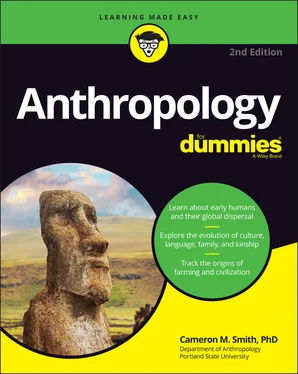So if the prosimians are so strange, why are they considered primates? Well, they generally have nails rather than claws, focus on vision rather than smell for their sensory specialty, have relatively mobile wrists and ankles, and live mostly in the trees. For all these reasons (as well as connections shown to the rest of the primates in the genetic data), the prosimians are, in fact, relations (albeit some pretty strange ones; of course, they could say the same about us). Because the prosimians are very much like the earliest primates, understanding them and what they can reveal about primate origins is important; unfortunately, they’re endangered.
 Many of the prosimians live on the island of Madagascar, off East Africa, where they’ve been isolated, in an evolutionary sense, for millions of years. Today almost 50 known species exist (two new species were discovered as recently as 2005), and, unfortunately, they’re all in danger of extinction. Humans first came to Madagascar just 1,500 years ago, and since that time many prosimian species have become extinct due to deforestation. You can keep up with these issues at
Many of the prosimians live on the island of Madagascar, off East Africa, where they’ve been isolated, in an evolutionary sense, for millions of years. Today almost 50 known species exist (two new species were discovered as recently as 2005), and, unfortunately, they’re all in danger of extinction. Humans first came to Madagascar just 1,500 years ago, and since that time many prosimian species have become extinct due to deforestation. You can keep up with these issues at www.wildmadagascar.org .
The monkeys of the Old World, members of the parvorder (a major division in the order) Catarrhini (meaning narrow-nosed) are distinct from the New World monkeys because they live on a different continent, distinct from the apes because the apes are generally larger, and different from the prosimians because they’re generally larger and have evolved more ecological adaptations than the prosimians. They also have the following distinctive anatomical characteristics:
Narrow nose with nostrils facing down (as opposed to wide-nosed, out-facing nostrils in New World monkeys)
A dental formula of 2.1.2.3 (one premolar fewer than the New World monkeys) with some species having molars shaped like knives for shearing vegetation
Lack of a prehensile tail (see the next section for more on prehensile tails)
Both arboreal and terrestrial lifestyles
The Old World monkeys are themselves split into at least two main groups: the subfamilies Cercopithecinae (including the terrestrial, brilliantly colored mandrill baboons) and Colobinae , which include the large-nosed proboscis monkey and the leaf-devouring colobus monkey, with its large, complex, leaf-digesting stomach. Old World monkeys live in diverse habitats, from dry African savanna to the snowy mountains of Japan. Africa’s patas monkey, distributed south of the Sahara, is a consummate survivor, consuming fruit, bird eggs, roots, and leaves; it can also sprint at up to 34 miles per hour, making it the fastest primate. Japanese snow monkeys spend winter hours soaking in natural hot springs.
The New World (South America) is home to primates as well; they’re members of the parvorder Platyrrhini, meaning “broad-nosed,” as compared to their Old World counterparts discussed in the last section. Shortly after the origin of the primates around 40 million years ago, South America was already sliding away from its previous link with Africa, and riding on it (or perhaps drifting to it on natural rafts of vegetation, purely by accident) were the ancestors of the New World monkeys. They survive into the present and have the following distinctive characteristics:
Wide nose (compared to the Old World monkeys)
Dental formula of 2.1.3.3 (an extra premolar)
Most have a prehensile tail used to grasp tree limbs
A completely arboreal lifestyle
The New World monkeys include the very loud howler monkey (which scares tourists because the howl sounds like a Hollywood jaguar), the fruit-eating spider monkey (which has a very handy prehensile tail), and the strange little marmosets, which live high in the trees on a diverse diet of insects, fruits, and leaves. Generally speaking, the New World monkeys are somewhat smaller than those of the Old World, with most species averaging about 7 kilograms (about 15 pounds).
The most human-esque group — the apes — are scientifically known as the Hominoidea, or “human-like” primates. Fossil evidence puts the origins of this group around 30 million years ago, in Africa’s middle Oligocene epoch. By 6 million years ago, a new group appeared in the Hominoidea — the Hominidae; these are the apes that walked upright, and one of their kind eventually evolved into the genus Homo , which evolved into Homo sapiens sapiens: humans. So, modern human origins can be traced by fossil evidence to Africa, 6 to 30 million years ago, in the evolution of the Hominoidea. Remember, we’re not the only member of the group, and our neighbor species, such as the chimpanzees and gorillas, have also survived all this time. ( Note: This classification is a bit of a gray area. Only recently have some anthropologists included chimps and gorillas in the same family as humans, as I do here; previously, Hominidae was reserved only for the bipedal primates.) The main anatomical characteristics of the Hominoidea are
Dental formula of 2.1.2.3
Lack of a tail
Both arboreal and terrestrial lifestyles
Relatively long arms (even with a terrestrial lifestyle) due to origins as tree-swingers
Simple molars for crushing, rather than the Old World Monkey’s shear-like molars
Relatively large body size, averaging more than 10 kilograms (30 pounds)
The Hominoidea is easily divisible into two main families, which mainly separate the Hominoidea into the somewhat monkey-like gibbons of Southeast Asia and the African apes.
The Hylobatidae contain the gibbons of Southeast Asia, who tear through the forest canopy like Tarzan and have complex vocalizations (also like Tarzan). They’re the lightest of the Hominoidea and the least like humans: They spend a lot of time in the trees, they have relatively small brains, and they survive on a diet that, although somewhat varied, is predominantly fruit.
Much more like humans are members of the Hominidae , the group containing the chimpanzee and gorilla (according to the DNA and skeletal evidence), and humans themselves. Generally speaking, these primates are large (averaging over 40 kilograms or 80 pounds), may live much of their lives on the ground, and have a generalized rather than specialized diet. They include Homo sapiens sapiens, a relatively large primate (averaging 70 kilograms or 140 pounds) that possesses a very large brain compared to body size and uses extremely complex behavior and tools to adapt and survive. That should sound familiar because you’re one of them.
 When you think about the past, and the fossil record, and the many individual primates that lie in your own past (right back to the first primates more than 60 million years ago), remember that a lot of speciations and extinctions have occurred. Generally speaking, most species (defined in the “Biological classification” sidebar earlier in the chapter) survive only about 4 million years; most genera survive for about 20 million years. Our species, Homo sapiens sapiens, has been around for about 100,000 years. But, as I discuss throughout this book, humanity is so different from most other life forms — for an array of reasons — that this natural timescale doesn’t necessarily apply to it. Humanity has invented many ways to prevent itself from falling prey to the circumstances that cause other species to become extinct (and at the same time has invented many means of committing suicide, such as nuclear and biological weapons).
When you think about the past, and the fossil record, and the many individual primates that lie in your own past (right back to the first primates more than 60 million years ago), remember that a lot of speciations and extinctions have occurred. Generally speaking, most species (defined in the “Biological classification” sidebar earlier in the chapter) survive only about 4 million years; most genera survive for about 20 million years. Our species, Homo sapiens sapiens, has been around for about 100,000 years. But, as I discuss throughout this book, humanity is so different from most other life forms — for an array of reasons — that this natural timescale doesn’t necessarily apply to it. Humanity has invented many ways to prevent itself from falling prey to the circumstances that cause other species to become extinct (and at the same time has invented many means of committing suicide, such as nuclear and biological weapons).
Читать дальше

 Many of the prosimians live on the island of Madagascar, off East Africa, where they’ve been isolated, in an evolutionary sense, for millions of years. Today almost 50 known species exist (two new species were discovered as recently as 2005), and, unfortunately, they’re all in danger of extinction. Humans first came to Madagascar just 1,500 years ago, and since that time many prosimian species have become extinct due to deforestation. You can keep up with these issues at
Many of the prosimians live on the island of Madagascar, off East Africa, where they’ve been isolated, in an evolutionary sense, for millions of years. Today almost 50 known species exist (two new species were discovered as recently as 2005), and, unfortunately, they’re all in danger of extinction. Humans first came to Madagascar just 1,500 years ago, and since that time many prosimian species have become extinct due to deforestation. You can keep up with these issues at 










